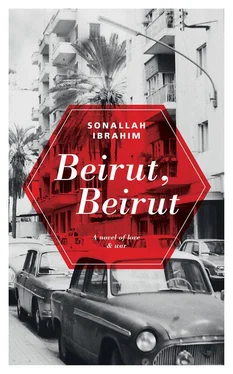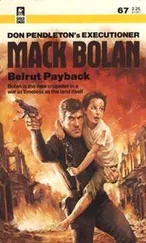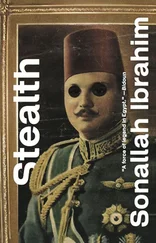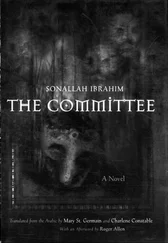A headline in the newspaper, Voice of the Tigers , the mouthpiece of Chamoun: “The theory of coexistence in Palestine came to an end in Lebanon.”
The headquarters of the Tigers forces. Chamoun reviews 3,000 Phalangist fighters in black uniforms on the drill field at their graduation from basic training. He addresses them, saying, “The war is a long one, and we are still at the beginning of the road.”
A Lebanese gunman carries an artillery piece, wearing an armband with the cedar emblem. He speaks in French in a filmed interview carried out by British actress Vanessa Redgrave: “Every Lebanese should kill a Palestinian.”
Pierre Gemayel and Camille Chamoun and Suleiman Frangieh walk through the gateway of an old palace. They are joined by Charbel Qassis in a sumptuously furnished reception hall.
A headline in a Phalangist newspaper: “Formation of a united military leadership headed by Bashir Gamayel.”
A headline in al-Safeer : “Jumblatt calls on the Palestinians to organize and form a provisional government.”
A newspaper headline: “George Habash, leader of the Popular Front for the Liberation of Palestine, criticizes the hesitation of the Lebanese National Movement to establish popular sovereignty.”
A newspaper headline: “Moscow criticizes the extreme right and extreme left in Lebanon.”
A newspaper headline: “Nayef al-Hawatmeh, the leader of the Democratic Front for the Liberation of Palestine, says: ‘A military settlement is impossible.’”
A newspaper headline: “Habash says: ‘No compromise. We will establish an Arab Hanoi.’”
A newspaper headline: “The fifth newspaper closure in Kuwait after parliament was dissolved and the constitution annulled due to fear of Lebanonization.”
Lebanon’s presidential palace in Baabda: the new president Elias Sarkis ascends the stairs.
Title card:
On September 21, 1976, Sarkis assumed the presidency from Frangieh, and immediately called on the Palestinian resistance to withdraw from Mount Lebanon.
Yasser Arafat to reporters: “All we ask is that he not stab us in the back and doesn’t bargain with us or over us.”
A newspaper headline: “Chamoun’s Tigers fire at Jumblatt’s car after his meeting with Sarkis.”
A newspaper headline: “Attack on the ship carrying Jumblatt to Cyprus.”
Damascus. Hafez al-Assad delivers an address to soldiers of the “Defense Squadrons”: “Your efforts in Lebanon and your opposition to the conspirators have prevented the division of Lebanon.”
West Beirut. Tripoli. Tyre. Sidon. Public events commemorating the sixth anniversary of the death of Gamal Abdel Nasser.
A newspaper headline: “The Soviet news agency Novosti on the anniversary of the death of Gamal Abdel Nasser: ‘His absence is strongly felt.’”
Newspaper headlines: “Syrian forces enter most villages on Mount Lebanon. Joint nationalist forces fight and retreat.” “Israeli sea blockade of Tyre and Sidon prevents the arrival of provisions and weapons for national forces.” “The political council for the Lebanese National Movement criticizes Arab silence and the neglect of international progressive movements.” “Bashir Gemayel declares: ‘We will liberate Lebanon even if the Syrians halt.’”
A newspaper headline: “Yasser Arafat to fighters: ‘To arms, for victory is at hand.’”
Damascus. President al-Assad makes a speech on television on the anniversary of the Yom Kippur War: “We are determined to continue to help Lebanon in order to rescue it from its sufferings and to preserve its independence and unity, and to save the Palestinian resistance.”
A circle around lines from a Soviet newspaper: “Events in Lebanon have cast doubt on the nationalism of Arab regimes with regards to Palestine.”
Riyadh Airport. King Khaled welcomes Sadat, Assad, Sarkis, Yasser Arafat and the Emir of Kuwait.
Beirut. Jumblatt to reporters: “The situation is in the hands of the oil states now.”
Large headlines in a Lebanese newspaper: “Riyadh conference resolves on a ceasefire in Lebanon beginning from October 21, 1976. The conference resolves to change the Arab security forces into a Deterrent Force under the command of Sarkis. The new force will be made up of 30,000 troops, the bulk of which will be Syrian forces (21,000 troops) in addition to two Saudi and Sudanese battalions.”
A photograph in a newspaper of the meeting between Jumblatt and Abu Jihad, the leader of the joint forces in Mount Lebanon and one of the most prominent Fatah leaders. Below the photo are two captions: “Abu Jihad: ‘All is lost in the civil war’” and “Jumblatt: ‘I demand a united position from the Palestinians.’”
Title card:
Finally the war halted.
Crowds of Beirut’s civilians welcome the armored cars of the Deterrent Forces. A welcome and a slaughtering of sheep in Chouf, Keserwan and Jbeil. The Deterrent Forces occupy military barracks next to official military organizations. Their tanks cruise through bombed-out streets.
Newspaper headlines: “Return of telephone service between the two parts of Beirut. Electricity back for 8 hours a day.”
A Beirut street. A bulldozer clears away rubble. In the middle of the street, a barricade made of two burned-out passenger cars.
A hospital room. In the center of it is a bed, with the independent Maronite leader Raymond Eddé lying on it. Jumblatt enters to visit. As he leaves he announces to a reporter: “I expect further assassination attempts.”
A newspaper headline: “Al-Sa’iqa organization attacks the Democratic Front to reclaim its headquarters in the Studio Building.”
Title card:
•The Swedish Red Cross announced that 700,000 Lebanese had been harmed in the war. And that 10,000 people are missing or unaccounted for in Lebanon.
•Losses to the telegraph and telephone systems were estimated at 110 million lira.
•Losses in capital in the years 1975 and 1976 were estimated at 700 million lira.
•Indirect losses to the national income in the manufacturing sector were 2.274 billion lira.
•Losses in imports were 5.35 billion lira.
•Losses in exports were 2.225 billion lira.
•The war made it necessary to restrict the number of Australia’s visas for Lebanese citizens to 9,000.
•It was estimated that the war left behind a quarter-million orphans.
Kamal Jumblatt to reporters: “America has paid out 250 million lira during the course of the war.”
The headquarters of the United Nations in New York. Votes are cast on a resolution for Israel’s withdrawal from occupied Arab regions, and for the founding of a Palestinian state. The resolution is approved, with ninety votes in favor and sixteen against.
Damascus. Abd al-Halim Khaddam, Syria’s foreign minister, to reporters: “Disarmament includes the Palestinian resistance movement. The criterion for its Arab nationalism is its relationship with Syria.”
Amin Gemayel to reporters: “The Syrian position has saved us some very difficult steps.”
The Beirut street where Kamal Jumblatt’s home is located. The remnants of a detonated car-bomb near his home. Pieces of flesh on tree branches. Blood stains a nearby white car. An ambulance carries the victims of the explosion. A doctor makes a public statement to a reporter: “So far, two killed and twenty-four wounded.”
A newspaper headline: “Elements from the al-Sa’iqa organization attack the offices of the al-Muharrir, Beirut and al-Dustur newspapers. Syrian spy agency attacks the offices of al-Safeer , arrests several of its editors, and transports them to a Damascus prison.”
A newspaper headline: “Jumblatt demands the resignation of Colonel Ahmad al-Hajj, head of the Deuxième Bureau, whom Sarkis appointed as chief of the Arab Deterrent Forces.”
Читать дальше












